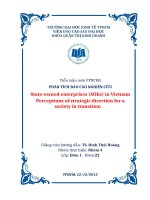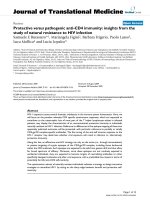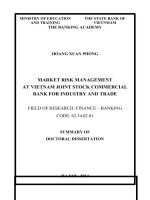Aromatic plants from Vietnam, sources of natural products for industry
Bạn đang xem bản rút gọn của tài liệu. Xem và tải ngay bản đầy đủ của tài liệu tại đây (136.7 KB, 9 trang )
29(4): 52-60
T¹p chÝ Sinh häc
12-2007
AROMATIC PLANTS FROM VIETNAM,
SOURCES OF NATURAL PRODUCTS FOR INDUSTRY
TRAN MINH HOI, TRAN HUY THAI
Institute of Ecology and biological Resources (IEBR)
ANGE BIGHELLI, JOSEPH CASANOVA
The Corsica Paul-Paoli University, French
ABSTRACT: aromatic plants produce by vapour distillation or other processes essential oils which are
products with high commercial value used in the natural product industries such flavour and fragrance,
perfumes and cosmetics industries as well as pharmaceutical industry. The aim of this study was to
characterise some aromatic plants from Vietnam through the chemical composition of their essential oils.
We got interested in essential oils which contained a main component with high to ultra high content,
susceptible to find an industrial use. For this study, a dozen of plants have been selected. The composition
of their essential oils will be compared with those of the same plants, reported in the literature, from
Vietnamese origin or from other countries.
Key words: Vietnam, Aromatic Plants, Essential oils, Agastache rugosa (Fisch. et Mey.) Kuntze, Blumea
myriocephala DC., Cinnamomum cassia Presl., Coleus aromaticus Benth., Cymbopogon martinii (Roxb.)
Wats., Eucalyptus citriodora Hook., Illicium verum Hook. f., Kaempferia galanga L., Ocimum basilicum
L. var. pilosum (Willd.) Benth., Ocimum gratissimum L., Michelia balansae (DC.) Dandy, Litsea cubeba
(Lour.) Pers., anethole, carvacrol, (E)-cinnanlaldehyde, Ethyl p-methoxy-(E)-cinnamate, citronellal,
eugenol, estragole, geraniol, linalool, thymyl methyl oxide, safrole.
Essential oils are obtained by water
distillation or vapour distillation of the whole
plant or part of the plant (aerial parts, leaves,
flowers, fruits, seeds, stems, wood, roots). They
are, in general, complexes mixtures of several
tens and sometimes more than one hundred
components, present in variable proportions.
The components are, most of the time, terpene
hydrocarbons or oxygenated terpenes containing
10, 15 and scarcely 20 atoms of carbon (mono,
sesqui and diterpenes), bearing very diverse
skeleton, acyclic, cyclic, bicyclic, polycyclic
(eventually bridged) and functionalities, olefins,
alcohols, aldehydes, ketones et esters.
Phenylpropanoids may be observed as well as
linear non terpenic compounds. However, a few
essential oils contain a main component which
is by far the most important and could constitute
an industrial source of this natural compound.
Such essential oils, with high commercial value,
could be of interest for natural product
industries such flavour and fragrance, perfume
and cosmetic industries as well as
52
pharmaceutical industry.
The world annual production of essential
oils was estimated to 45,000 tons which
represented in the early nineteen’s a value of
700 millions of US dollars. The essential oils,
which are obtained without the use of solvent or
reactant are free of chemical pollution.
Moreover, in most cases, the plant produces a
single enantiomer of a molecule, enantiomer
which possesses specific olfactory or
pharmaceutical properties.
This study was achieved in the course of an
important work concerning the characterization
of aromatic plants from Vietnam through the
chemical composition of their essential oils. We
got interested in essential oils which contained a
main component with high to ultra high content,
susceptible to find an industrial use. For this
study, a dozen of plants have been selected. The
composition of their essential oils will be
compared with those of the same plants,
reported in the literature from Vietnamese
origin or from other countries.
I. EXPERIMENTAL METHODS
1. Analytical GC
GC analysis was carried out with a PerkinElmer Autosystem apparatus equipped with two
flame ionisation detectors, and fused-silica
capillary columns (50 m × 0.22 mm i.d., film
thickness 0.25 µm), BP-1 (polydimethylsiloxane)
and BP-20 (polyethyleneglycol). The oven
temperature was programmed from 60°C to
220°C at 2°C/min and then held isothermal
(20 min); Detector temperature: 250°C;
Injector temperature: 250°C (injection mode:
split 1/60). Carrier gas: helium (0.8 mL/min).
Injected volume: 0.5 µl of a solution of 50 µl of
the oil diluted in 350 µl of CCl4 acquired oven
the mass range 35-350 Da. Split: 1/80. Other GC
conditions were the same as described under
GC. GC-MS analyses were carried out on both
columns.
2. 13C-NMR Analysis
All NMR spectra were recorded on a Bruker
AC 200 Fourier transform spectrometer
operating at 50.323 MHz for 13C, equipped with
a 10 mm [or 5 mm] probe, in CDCl3, with all
shifts referred to internal TMS. 13C-NMR
spectra were recorded with the following
parameters: pulse width (PW), 5 µs [or 3 µs]
(flip angle 45°); acquisition time, 1.3 s for 32 K
data table with a spectral width (SW) of 12 500
Hz (250 ppm); CPD mode decoupling; digital
resolution 0.763 Hz/pt.
In a typical procedure, 200 mg [or 70 mg] of
the essential oil were diluted in 2 ml [or 0.5 ml]
of CDCl3. The number of accumulated scans
was 3000 - 6000 for each sample, depending on
the quantity of the oil available. Exponential
line broadening multiplication (LB = 1 Hz) of
the free induction decay (FID) was applied
before Fourier transformation.
3. Identification of components
Identification of the individual components
was based: (i) on comparison of their GC
retention indices (RI) on apolar and polar
columns, determined relative to the retention
times of a series of n-alkanes with linear
interpolation (‘Target Compounds’ software of
Perkin-Elmer), with those of authentic
compounds or literature data, (ii) on computer
matching with a laboratory made mass spectral
library and commercial libraries and comparison
of spectra with literature data, (iii) on comparison
of the signals in the 13C-NMR spectra of the
selected samples with those of reference spectra
compiled in the laboratory spectral library, with
the help of a laboratory-made software [15, 16].
II. RESULTS AND DISCUSSION
Among the numerous plant of Vietnamese
origin we have investigated within a research
program sponsored by the French Foreign
Ministry and the CollectivitÐ Territoriale de
Corse [11], we have selected a dozen of
aromatic plants which produce an essential oil
dominated by a single component. The content
of that compound in the oil may be high, very
high or extremely high and consequently, the
essential oil could be a source of this compound
for the industry of natural products.
The essential oils of six aromatic plants
contained mainly a component bearing the
phenylpropanoid framework. This compound is:
Anethol in the oil from star anis, Illicium verum
Hook. f.; Estragole in the oil from Agastache
rugosa (Fisch. et Mey.) Kuntze; Eugenol in the
oil from Ocimum gratissimum L.; safrole in the
oil from Michelia balansae (DC.) Dandy; (E)cinnamaldehyde in the oil from Cinnamomum
cassia (Nees) Nees et Eberh; (E)-ethyl cinnamate
and (E) para-methoxy-ethyl cinnamate in the oil
from Kaempferia galanga L.
The six other essential oils are dominated by
aromatic or acyclic monoterpenes; they are:
Carvacrol in the essential oil from Coleus
aromaticus Benth.; Thymyl methyl oxide in the
oil from Blumea myriocephala DC.; Linalool in
the oil from Ocimum basilicum L. var. pilosum
(Willd.) Benth; Citronellal in the oil from
Eucalyptus citriodora Hook.; Geraniol in the oil
from Cymbopogon martinii (Roxb.) Wats.;
Citral (geranial and neral mixture) in the oil
from Litsea cubeba (Lour.) Pers.
Although, in the course of this program, we
have analysed several samples of essential oil
extracted from the investigated plants, we only
report in the tables 1 and 2, the chemical
composition one sample. The chemical
structures of the main compounds are reported
in the figure 1.
53
Table 1
Chemical composition of phenylpropanoid rich oils from Vietnam (samples 1-6)
Components
RI
1
2
3
4
5
6
931
1.4
α-pinene
972
3.0
β-pinene
Limonene
1021
2.5
1.8
4.8
1024
1.4
(E)-β-ocimene
Linalool
1081
1.4
Estragole
1124
96.2
Borneol
1149
0.4
3.1
(E)-cinnamaldehyde
1236
92.4
Safrole
1262
84.5
(E)-anethole
1268
93.1
Cinnamyl alcohol
1270
0.4
Eugenol
1337
82.7
1379
1.7
α-copaene
Coumarin
1388
0.7
Cinnamyl acetate
1409
0.6
(E)-trans-caryophyllene
1424
3.8
(E)-ethyl cinnamate
1434
26.8
Germacrene-D
1480
1.1
1516
1.5
δ-cadinene
(E)-ethyl p-methoxy cinnamate
1719
64.1
Note: order of elution, retention indices (RI) and percentages are given on apolar column (BP-1). Investigated
plants: 1. Illicium verum; 2. Agastache rugosa; 3. Ocimum gratissimum; 4. Michelia balansae; 5.
Cinnamomum cassia; 6. Kaempferia galanga.
Table 2
Chemical composition of monoterpenoid rich oils from Vietnam (samples 7-12)
Components
RI
7
8
9
10
11
p-cymene
1011
2.7
0.8
Limonene
1021
9.5
1048
2.3
γ-terpinene
2.9
Linalool
1081
79.0
1.6
Citronellal
1136
78.2
Isopulegol
1136
5.6
Neoisopulegol
1146
3.2
Terpinen-4-ol
1160
1.3
Citronellol
1210
4.9
Nerol
1211
0.9
Thymyl methyl oxide
1214
97.7
Neral
1214
26.8
1.1
Geraniol
1232
Geranial
1237
44.1
Carvacrol
1278
82.7
Citronellyl acetate
1334
0.8
Eugenol
1337
1.3
54
12
3.4
1.7
69.2
4.4
-
Geranyl acetate
Aristolene
(E)-trans-caryophyllene
Trans-α-bergamotene
α-humulene
β-selinene
α-selinene
Caryophyllene oxide
1357
1420
1424
1432
1456
1485
1494
1579
2.6
1.9
0.7
-
1.1
-
2.9
2.2
2.5
2.2-
-
1.9
-
12.1
1.1
Note: order of elution, retention indices (RI) and percentages are given on apolar column (BP-1). Investigated
plants: 7: Coleus aromaticus, 8: Blumea myriocephala, 9: Ocimum basilicum var. pilosum, 10: Eucalyptus
citriodora, 11: Litsea cubeba, 12: Cymbopogon martinii.
O
O
HO
O
E -anéthole
estragole
eugénol
O
O
O
H
safrole
O
O
(E )-cinnam aldéhyde
O
(E )-para-m éthoxycinnam ate
d'éthyle
OH
OH
O
carvacrol
oxyde de m éthyle
et de thym yle
linalol
H
OH
O
citronellal
O
géranial
géraniol
néral
H
O
Figure 1. Structure of the major components identified in essential oils from Vietnam
55
1. Illicium verum Hook. f. (star anis)
essential oil, source of (E)-anethole
Illicium verum (star anis) is widely
cultivated in Vietnam and used as medicinal
plant [12a]. The analysed sample contained 93%
of (E)-anethole [synonym (E)-1-methoxy-4-(1propenyl)-benzene; (E)-4-(1-propenyl)-anisole]
and 2.5% of limonene, the single one other
compound present at noticeable content.
Anethole is widely used in the production of
fragrances and it is particularly present in soaps
and in cleaning materials. The (E) isomer is
rather used as floral base in the products
intended for fine perfumery. Essential oil of
Illicium verum possess an interesting
antimicrobial activity, specially induced by the
presence of anethole. The content of (E)anethole in this sample is very high, compared
to those reported in the literature [1, 2] and
reviewed by Lawrence [7]: 71-78% for the oils
from China in which the major compound is
present with another oxygenated compound as
anisaldehyde, estragole or foeniculine; 88% for
samples from unspecified origin.
2. Agastache rugosa (Fisch. et Mey.) Kuntze
essential oil, source of estragole
The investigated sample contained 96% of
estragole [synonym = 1-methoxy-4-allylbenzene,
4-allylanisole, methylchavicol]. It possess an
herbaceous odour slightly similar to that of anis
and it is used for the preparation of synthetic
oils such as
estragon oil. The chemical
composition of this sample is close to that
reported by Dung et al in which the content of
estragole varied from 76 to 92%, according to
the part of the plant. It seems that the chemical
composition of the essential oil of Agastache
rugosa from Vietnam is more homogeneous
than that reported by Fujita (estragole and
methyleugenol: 83-92%) or by Svoboda et al
(estragole and menthone and/or isomenthone,
plant cultivated in Scotland) and is quite
different to that reported by Lawrence
(isomenthone 10-57%, pulegone 9-52%, plant
cultivated in North Carolina).
3. Ocimum gratissimum L. essential oil,
source of eugenol
The analysed sample is characterised by the
56
predominance of eugenol (83%) [synonym: 2methoxy-4-allylphenol, 1-hydroxy-2-methoxy4-allylbenzene]. We noticed that the other
components present at a content which allows
their identification by 13C-NMR are all
sesquiterpenes: (E)-caryophyllene, α-copaene,
δ-cadinene and D-germacrene. Eugenol is
widely used in pharmacy, perfumery, cosmetic
and agribusiness (meats, sausages and sauces)
due to its strange and pleasant smell of clove.
The essential oil of Ocimum gratissimum, that
possess an important antibacterial activity, was
widely studied and several chemical
compositions have been reported. Concerning
the two more important compositions, one is
dominated by eugenol and the other by thymol
[1, 2]. Our sample, that belongs to the first
composition, is similar to that reported by Dung
et al (eugenol, 74%), also from Vietnam. It is
also similar to the eugenol rich oils (32-90%)
reported by Lawrence from China, USSR, India,
Madagascar, Taiwan, North America and from
unspecified origin. However, the chemical
composition of our sample differed from those
of the oils from Rwanda, Cuba, Bangladesh,
Benin and Sao-Tome and Principe, characterised
by a high content of thymol (35-60%).
Otherwise, our sample is also different to the
other samples reported in the literature with
unusual chemical compositions: 2 samples from
Brazil, respectively dominated by methyleugenol/eugenol and by p-cymene/(E)-βfarnesene/thymol; one sample characterised by
β-caryophyllene/eugenol/β-elemene (unspecified
origin); some compositions dominated by
linalool, citral or ethyl cinnamate have been also
reported.
4. Michelia balansae (DC.) Dandy essential
oil, source of safrole
We analysed a sample of essential oil
obtained from the aerial parts of Michelia
balansae (DC.) Dandy (Magnoliaceae). Six
compounds, amounting for 97% of the global
composition, were identified. Safrole [synonym
4-allyl-1,2-methylenedioxybenzene,
3,4methylenedioxyallylbenzene] is the major
component (85%). The five other important
components (1.4 - 4.8% each) are all
monoterpenes. Safrole possesses a smell similar
to that of sassafras and it is widely used as
flavour
(drinks,
chewing-gums),
in
pharmaceuticals (tooth pastes) and in the
manufacture of detergents (soaps). The
chemical composition of our sample is similar
to those reported by Dung et al for essential oils
obtained from seeds and pulp of fruits from
Vietnam. The last oils contained also safrole (73
and 70%, respectively) together with
methyleugenol (19 and 24%, respectively) not
present in our sample at a content sufficiently
high to be identified by 13C-NMR. However, the
investigated sample differed drastically from
those of trunk (camphor 24%), bark (camphor
16%, safrole 15%, β-caryophyllene 16.9% and
elemicine 14%) and leaves (elemicine 46.3%
and β-caryophyllene 16.9%) which exhibited a
higher content of terpenes.
5. Cinnamomum cassia (Nees) Nees et
Eberh. essential oil, source of (E}cinnamaldehyde
Cinnamomum cassia (Nees) Nees et Eberh.
was introduced since a long time in Vietnam
were it is cultivated in the mountainous regions
particularly for its cork which can be harvested
when the tree is 8 - 10 years old (12c). The cork
oil contains 60 - 75% (E)-cinnamaldehyde
[synonym = (E)-3-phenylpropenal] [12c]. In the
investigated samples of this study, the content
of (E)-cinnamaldehyde reached up to 90% of
the composition of the oils extracted from cork,
stems and trunk of Cinnamomum cassia. In the
sample whose composition is reported in the
table 1, we noted the occurrence, obviously at
low level of cinnamyl alcohol an d the
corresponding acetate, as well as borneol, a
monoterpene alcohol, coumarin, a compound
scarcely found in essential oils and which may
result from the cyclisation of 3-phenylprop-2enoic acid. Due to its strong spiced odour, Ecinnamaldehyde is used as a precious ingredient
in perfumery. The composition of the
investigated sample is close to that of the
essential oil, also of Vietnamese origin, reported
by Nguyen Thi Tam et al.. Such a composition
dominated by E-cinnamaldehyde is extensively
reported in the literature [1, 2] and reviewed by
Lawrence [6]: although E-cinnamaldehyde is
always the main component, its content varied
from 55 to 97% of the whole composition of the
essential oils, depending of the part of the plant
hydrodistilled (leaves, branches or cork) as well
as the origin of the plant. E-cinnamaldehyde is
associated to benzaldehyde, coumarin, 2methoxycinnamaldehyde
or
sometimes,
sesquiterpenes.
6. Kaempferia galanga L. essential oil,
source
of
(E)Ethyl
paraEthoxycinnamate
and
(E)Ethyl
cinnamate
Kaempferia galanga (Zingiberaceae) is a
tropical species scarcely found in the wild in
Vietnam [12d]. The plant is cultivated in India
an in Vietnam and is used as spice. In the folk
medicine, the plant is known to facilitate
digestion [12d]. The essential oil is extracted
from rhizomes. The investigated sample was
characterised by the occurrence of Ethyl (E)cinnamate and overall its para-methoxylated
derivative, Ethyl (E)-para-methoxycinnamate,
the two compounds accounting for 37 et 64% of
the composition of the essential oil,
respectively. The chemical composition of that
sample is in agreement with those reported in
the literature [1, 10].
7. Coleus aromaticus Benth. essential oil,
source of carvacrol
Coleus aromaticus Benth. (synonyms =
Coleus amboinicus Lour., Plectranthus
amboinicus Lour.) is cultivated in Vietnam
since a long time, in the central part of the
country. Leaves contain an essential oil which
has an antibacterial activity [7e]. Carvacrol [2methyl-5-isopropylphenol,
2-hydroxy-paracymene] is reported as the main component of
Coleus
aromaticus
oil
obtained
by
hydrodistillation [1, 2]. The investigated
samples presented an extremely high content of
carvacrol (83%). Beside the main component
and few monoterpenes, we observed the
occurrence of several olefinic sesquiterpenes,
(E)-β-caryophyllene, trans-α-bergamotene, αhumulene. Like thymol, carvacrol possesses
antiseptic and germicide properties. For
comparison purposes, the sample of Vietnamese
origin, analysed by Dung et al. contained only
40% of carvacrol. The content in carvacrol of
the investigated sample is higher than that of
several samples of different origins and reported
57
in the literature: Martinique (72%), India (60%),
Cuba (51%), Mauritius Island (40%) and
Pakistan (40%). Conversely, the composition of
our sample differed drastically from that of
samples containing 41% et 80% de thymol
respectively, one from Pakistan, the other of
undetermined origin as well as from that of a
sample from Seychelles which was dominated
by p-cymenene (46%).
8. Blumea myriocephala DC. essential oil,
source of thymyl mehyl oxide
The investigated sample was characterised by
the pre-eminence of thymyl methyl oxide which
accounted for 98% of the chemical composition
of B. myriocephala leaf oil from Vietnam. The
composition is close to that reported by Dung et
al. for an essential oil extracted from fresh leaves
and stems of B. lanceolaria also of Vietnamese
origin, (thymyl methyl oxide about 95% of the
composition). Conversely, the two compositions
are drastically different from that reported for an
oil of B. myriocephala of Indian origin
characterised
by
the
occurrence
of
chrysanthenone (37%), a monoterpene ketone
bearing the bridged bicyclic skeleton of pinane,
and by several others linear non terpenic
compounds.
9. Ocimum basilicum var. pilosum (Willd.)
Benth. essential oil, source of linalool
Ocimum basilicum var. pilosum is used for
flavouring foods as well as in cosmetics and
fragrances industries [1, 2]. The essential is
obtained by water distillation of the aerial parts
or only of the flowers. Several studies on the
chemical composition of O. basilicum essential
oils have been reported and reviewed by
Lawrence [9]. Among them, the two most
common were characterized by the preeminence of methylchavicol (La Reunion,
Comoros, Seychelles and Madagascar islands,
India, Thailand, Cuba, Nigeria) [9], Vietnam
[9], or by the presence of linalool (France, Italy,
Spain, Hungaria, Poland, Turkey, USA and
Africa) [9]. Two other chemical compositions of
basil oil were reported in the literature, the
major components being methyl cinnamate (Fiji
islands, Morocco) and eugenol (accompanied by
linalool) [9], respectively. Finally, atypical
chemical
compositions
exhibiting
58
dihydrotagetone, menthol and menthone as
major components were described in the
literature [9]. Several of these compositions
were found in the essential oils extracted from
plants of O. basilicum, of Comorian origin and
cultivated in Vietnam and which have been
analysed in our laboratories [13]. The
investigated sample was characterized by the
presence of a high content of linalool [3,7dimethylocta-1,6-dien-3-ol] (79%) and 4
hydrocarbon
sesquiterpenes:
(E)-βcaryophyllene (2.9%), trans-α-bergamotene
(2.2%) and the two isomers β- and α-selinenes
(which amounted respectively for 2.5 and
2.2%). Because of its pleasant odour of lily of
the valley, linalool is one of the most important
compounds for industries of perfumery,
cosmetics and detergents.
10. Eucalyptus citriodora Hook. essential oil,
source of citronellal
The Vietnamese essential oil of Eucalyptus
citriodora exhibited a high content (78%) of
citronellal
[3,7-dimethyloct-6-en-1-al],
a
monoterpene aldehyde which exhibited an
odour of Melissa appreciated in the perfume and
also in the detergent industries. Moreover,
citronellal can be used like the starting material
for the synthesis of menthol, an interesting
compound for perfumery and food industries.
The investigated sample of E. Citriodora,
contained also citronellol and its acetate as well
as two isomers of isopulegol. The chemical
composition of the Vietnamese essential oil is as
usual and its content of citronellal was fair in
comparison with those reported in the literature
[7]: Argentina (56%), Benign (65%), China
(67%), Cuba (75%), Brazil (76%), Spain (80%),
Kenya (88%) and India (90%). Conversely, our
sample differed from the citronellol rich oil (5670%) from Colombia and the 1,8-cineole rich
oil (55%) of Rwanda.
11. Litsea cubeba (Lour.) Pers., source of
citral
In Vietnam, Litsea cubeba (Lour.) Pers.
(synonym: Litsea citrata Blume) is abundant in
the hills and mountains at an altitude between
500 and 1000 m. The essential oil which was
extracted from the fruit belongs to the 10 most
important oils in terms of commercial value.
Citral and methylheptenone, the two major
components of the oil, amounted respectively for
70% and 20% approximately [12e]. The
Vietnamese essential oil, obtained by water
distillation of fruits of L. cubeba, was
characterized by the presence of the high content
(70%) of citral (mixture of geranial [3,7dimethyl-octa-2(E),6-dienal] and neral [3,7dimethyl-octa-2(Z),6-dienal]). Citral was used as
ingredient in the lemon- and orange-flavoured
non natural perfumes, but also in the detergent
and cosmetic industries. In addition to the two
isomer aldehydes, the essential oil exhibited the
presence of several monoterpenes and one
sesquiterpene: aristolene (1.9%), which was not
yet found in the essential oils from Vietnam. The
chemical composition of our sample was close to
that of other samples coming from various
Vietnamese
provinces
[14]
in
which
epoxygeranial and epoxyneral were identified as
probably secondary products of distillation
process. Several studies on the chemical
composition of L. cubeba fruit oil have been
reported in the literatures [1, 2] and reviewed by
Lawrence and Choudhury et al. Its appears, that
the chemical composition of the investigated oil
was intermediate between that of the Indian
sample in which citral amounted for more than
90% and those of the oils from China and
Thailand where citral (50-63%) was identified in
presence of an appreciable amount of limonene
(23-25%). Conversely, it differs drastically from
the the chemical composition of an essential oil
from India in which citronellal (45-77%) was the
major compound. The leaf essential oil from
Vietnam was investigated and it was
characterized by an chemical variability [3].
12. Cymbopogon
geraniol rich
martinii
(Roxb.)
Wats.,
Cymbopogon martinii (Roxb.) Wats.
(Poaceae) was introduced recently in Vietnam
(1982) [12e]. Geraniol [3,7-dimethylocta2(E),6-dien-1-ol] was the major compound
(69%) of the essential oil of palmarosa obtained
from C. martini, the second compound in
importance being its acetate. Linalool, geranial
and neral were present at low contents. Like
linalool, geraniol is an invaluable ingredient
used and appreciated in industries of perfumery,
cosmetics and detergents for its pleasant odour
of rose. The chemical composition of the
investigated Vietnamese oil was close to those
obtained from Vietnam and reported by Dung et
al. in which geraniol amounted for 72%. The
content of geraniol in our samples was
completely acceptable in comparison of those
from various origins reported in the literatures
[1, 2] and reviewed by Lawrence [8]: 92 and
80% in Brazil, 84% in Madagascar, 76% in
India, 60% in Guatemala and from 50 to 80%
for samples of which the origin was not
specified.
III. CONCLUSION
In the course of the French - Vietnamese
program (CoopÐration dÐcentralisÐe RÐgion
Corse - Provinces du Nord - Vietnam), our two
groups worked on more of fifty aromatic plants
from Vietnam: selection of plants, sampling,
harvest, extraction of essential oils, analysis by
several complementary techniques, detailed
study with or without fractionation on column
chromatography, chemical variability°. Among
these plants, we selected a dozen which
produced an essential oil dominated by a single
component. The essential oil may be considered
as a potential source of that natural compound.
We have compared our results with those
reported in the literature from Vietnam or from
other origin.
Acknowledgements: the authors are indebted to
the CollectivitÐ territoriale de Corse, the French
Foreign Ministry of French and the Caisse des
DÐp«ts et Consignations for financial support
(Programme de coopÐration dÐcentralisÐe Corse
- Vietnam) and the SociÐtÐ Montier
(Ghisonaccia Corsica) for a research grant and
to the Program of basic researches, Vietnam for
financial support.
REFERENCES
1. Arctander S., 1960: Perfume and Flavor
Materials of Natural Origin, Elizabeth NJ,
U. S. A.
2. Bauer K., Garbe D. and Surburg H.,
1990: Common fragrance and flavor
materials, VCH Publishers, New York.
3. Bighelli A. et al., 2005: J. Essent. Oil Res.,
in press.
59
4. Chalchat J. C. et al., 1997: Rivista Italiana
EPPOS, numero speciale: 644.
5. Dung N. X. et al., 1996: J. Essent. Oil Res.,
8: 135-138.
6. Lawrence B., 1995: Essential Oils,
Cinnamomum cassia, 1992-94, 163; 1978, l,
13; 1976-1977, 10, 22, Allured Publishing
Corporation, Carol Stream.
7. Lawrence B., 2003: Perfum. & Flavor.,
28(6): 56-75.
8. Lawrence B., 1981-87, 1988: Essential
Oils, Cymbopogon martinii: 92, 81; 237.
9. Lawrence B., 1995, 1998: Perfum. &
Flavor., 20: 35- 37; 23(6): 35.
10. Luger P., Weber M., Dung N. X. and
Tuyet T. B., 1995: J. Applied
Crystallographica, C51.
11. Muselli A., Tran Minh Hoi, Luu Dam Cu,
La Dinh Moi, Bessiere J.-M., Bighelli A.,
Casanova J., 1999: Flavour Fragr. J., 14:
41-44.
12. National Institute of Materia Medica,
1999: a) vol 2: 34-38; b) vol 2: 146-148; c)
vol 1: 193-200; d) vol 2: 42-46; e) vol 2: 6265; f) vol 1: 271-275. Selected Medicinal
Plants in Vietnam, Science & Technology
Publishing house, Hanoi, Vietnam.
13. Nguyen Thi Phuong Thao et al., 1999:
Revue pharmaceutique, l: 14-20.
14. Nguyen Thi Tam et al., 2005: Revue
Chimique, in Press.
15. Tomi F et al., 1995: J. Magn. Reson. Anal.,
l: 25-32.
16. Tomi F., Casanova J., 2000 : Ann. Fals
Exp. Chim., 93(952): 313-330.
CÂY Có TINH DầU CủA VIệT NAM,
NGUồN SảN PHẩM THIÊN NHIÊN DùNG CHO CÔNG NGHIệP
Trần Minh Hợi, Trần Huy Thái,
Ange Bighelli, Joseph Casanova
TóM TắT
Tinh dầu thu đợc bằng phơng pháp chng cất lôi cuốn hơi nớc và một số phơng pháp khác là những
sản phẩm có giá trị thơng mại cao dùng trong công nghiệp hơng liệu, nớc hoa và mỹ phẩm. Mục tiêu của
công trình này là đánh giá một số cây có tinh dầu của Việt Nam thông qua thành phần hoá học trong tinh dầu.
Chúng tôi rất quan tâm những loại tinh dầu có chứa một hợp chất chính với hàm lợng từ cao đến cực cao
có thể sử dụng trong các ngành công nghiệp. Trong bài báo này, chúng tôi đã lựa chọn 12 cây có tinh dầu có
tiềm năng phát triển lớn ở Việt Nam để nghiên cứu. Thành phần hoá học trong tinh dầu của chúng đợc so
sánh với cùng một loài đã đợc công bố trong các tài liệu ở Việt Nam cũng nh các nớc khác.
Ngày nhận bài: 8-2-2007
60









